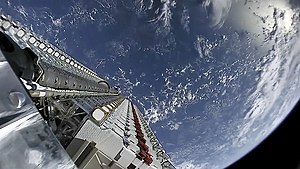
Back Starlink Afrikaans Starlink AN ستارلنك Arabic ستارلنك ARZ Starlink Azerbaijani Starlink BAT-SMG Starlink BCL Starlink Bulgarian স্টারলিঙ্ক Bengali/Bangla Starlink Catalan
 60 Starlink Satellites stacked together before deployment on May 24, 2019 | |
| Manufacturer | SpaceX |
|---|---|
| Country of origin | United States |
| Operator | Starlink Services, LLC (a wholly-owned subsidiary of SpaceX) |
| Applications | Internet service |
| Website | www |
| ASN | |
| Specifications | |
| Spacecraft type | Small satellite |
| Launch mass | |
| Equipment |
|
| Regime | |
| Production | |
| Status | Active since 2019 |
 | |
Starlink is a satellite internet constellation operated by Starlink Services, LLC, a wholly-owned subsidiary of American aerospace company SpaceX,[3] providing coverage to 80 countries. It also aims to provide global mobile broadband.[4]
SpaceX started launching Starlink satellites in 2019. As of early March 2024, it consists of over 6,000 mass-produced small satellites in low Earth orbit (LEO)[5] that communicate with designated ground transceivers. Nearly 12,000 satellites are planned to be deployed, with a possible later extension to 34,400. SpaceX announced reaching more than 1 million subscribers in December 2022,[6] 2 million subscribers in September 2023,[7] and 3 million subscribers in May 2024.[8]
The SpaceX satellite development facility in Redmond, Washington houses the Starlink research, development, manufacturing and orbit control facilities. In May 2018, SpaceX estimated the total cost of designing, building and deploying the constellation would be at least US$10 billion.[9] Revenues from Starlink in 2022 were reportedly $1.4 billion accompanied by a net loss, with a small profit being reported starting in 2023.[10] Revenue is expected to reach $6.6 billion in 2024.[11]
Starlink has been extensively used in the Russo-Ukrainian War, a role for which it has been contracted by the United States Department of Defense.[12] Starshield, a military version of Starlink, is designed for government use.[13][14]
Astronomers have raised concerns about the effect the constellation may have on ground-based astronomy, and how the satellites will contribute to an already congested orbital environment.[15][16] SpaceX has attempted to mitigate astronometric interference concerns with measures to reduce the satellites' brightness during operation.[17] They are equipped with Hall-effect thrusters allowing them to orbit raise, station-keep, and de-orbit at the end of their lives. They are also designed to autonomously and smoothly avoid collisions based on uplinked tracking data.[18]
- ^ Sesnic, Trevor (January 8, 2022). "Starlink Group 4-5 | Falcon 9 Block 5". Everyday Astronaut. Archived from the original on January 10, 2022. Retrieved January 2, 2023.
- ^ Cite error: The named reference
sfn-212306was invoked but never defined (see the help page). - ^ SpaceX (February 3, 2021). "Petition of Starlink Services, LLC for Designation as an Eligible Telecommunications Carrier" (PDF). Federal Communications Commission. Retrieved March 29, 2024.
As the Commission knows, SpaceX assigned its winning RDOF bids to Starlink Services, its wholly-owned subsidiary, on December 22, 2020. An intercompany agreement provides Starlink Services, LLC with access to all space and terrestrial assets and infrastructure needed from SpaceX to deploy and operate the Starlink service.
- ^ Cite error: The named reference
cnbc-20220825was invoked but never defined (see the help page). - ^ McDowell, Jonathan (January 3, 2024). "Starlink Launch Statistics". Jonathan's Space Pages. Archived from the original on December 10, 2023. Retrieved January 3, 2023.
- ^ @SpaceX (December 19, 2022). "Starlink now has more than 1,000,000 active subscribers" (Tweet). Archived from the original on July 30, 2023. Retrieved March 13, 2023 – via Twitter.
- ^ @Starlink (September 23, 2023). "Starlink is available on all 7 continents, in over 70 countries and many more markets, connecting 2M+ active customers and counting with high-speed internet!" (Tweet). Archived from the original on September 23, 2023. Retrieved September 24, 2023 – via Twitter.
- ^ @Starlink (May 20, 2024). "Starlink is connecting more than 3M people with high-speed internet across nearly 100 countries, territories and many other markets. Thank you to all of our customers around the world!" (Tweet). Retrieved May 21, 2024 – via Twitter.
- ^ Cite error: The named reference
nsf20180517was invoked but never defined (see the help page). - ^ Maidenberg, Micah; Winkler, Rolfe (September 13, 2023). "Starlink Surges but Is Still Far Short of SpaceX's Goals, Documents Show". The Wall Street Journal. Archived from the original on November 23, 2023. Retrieved November 19, 2023.
- ^ Berger, Eric (May 10, 2024). "Analyst on Starlink's rapid rise: "Nothing short of mind-blowing"". Ars Technica. Retrieved May 11, 2024.
- ^ Macias, Amanda; Sheetz, Michael (June 1, 2023). "Pentagon awards SpaceX with Ukraine contract for Starlink satellite internet". CNBC. Archived from the original on September 15, 2023. Retrieved September 15, 2023.
- ^ Cite error: The named reference
:starshieldsitewas invoked but never defined (see the help page). - ^ Cite error: The named reference
:starshieldSheetzwas invoked but never defined (see the help page). - ^ Drake, Nadia (May 29, 2019). "Will Elon Musk's Starlink satellites harm astronomy? Here's what we know". National Geographic. Archived from the original on March 9, 2021. Retrieved March 12, 2021.
- ^ "JASON Report on the Impacts of Large Satellite Constellations". National Science Foundation. Archived from the original on October 20, 2021. Retrieved October 20, 2021.
- ^ "Astronomy Discussion with National Academy of Sciences" (Press release). SpaceX. April 28, 2020. Archived from the original on May 16, 2021. Retrieved April 4, 2021.
- ^ Cite error: The named reference
gunther-starlink-v1.0was invoked but never defined (see the help page).
© MMXXIII Rich X Search. We shall prevail. All rights reserved. Rich X Search